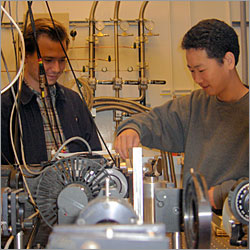
33-Year Hunt for Proof of Spin Current Now Over, Announced in Science
Spin Hall Effect Observed
Research Team Led by UCSB's David D. Awschalom of the Center for Spintronics and Quantum Computation announces breakthrough in spintronics
 Santa Barbara, Calif. - November 11, 2004 -In a paper published online today in Science (http://www.sciencexpress.org/), a group of researchers led by David Awschalom, a professor of physics and electrical and computer engineering at the University of California, Santa Barbara, reports the observation of the spin Hall
effect. This publication ends a 33-year long effort aimed at this discovery. Santa Barbara, Calif. - November 11, 2004 -In a paper published online today in Science (http://www.sciencexpress.org/), a group of researchers led by David Awschalom, a professor of physics and electrical and computer engineering at the University of California, Santa Barbara, reports the observation of the spin Hall
effect. This publication ends a 33-year long effort aimed at this discovery.
The Hall effect, named after American physicist Edwin Hall who discovered it in 1879, occurs when an electric current flows through a conductor in a magnetic field, creating a measurable transverse voltage. On a fundamental level, this effect originates because the magnetic field exerts a force on the moving charge carriers, which pushes them to one side of the conductor. The resulting buildup of charge at the sides of the conductor ultimately balances this magnetic field- induced force, producing a measurable voltage between opposite sides of the conductor.
In 1971, M.I. D'yakonov and V. I. Perel, two Russian physicists, predicted theoretically that a similar effect is expected in the realm of magnetization or spin physics. While the conventional Hall effect is widely used in today's sensors and electronics, the spin Hall effect has defied experimental detection for 33 years. In analogy to its more conventional sibling, in the spin Hall effect, current-carrying electrons with opposite spins are predicted to move toward opposite sides of a semiconductor wire even without a magnetic field or magnetic materials. This spin Hall effect results in the accumulation of spins at the edges of the sample with opposing spin polarization. In short, this phenomenon refers to
the generation of a pure spin current transverse to an applied electric field: the flow of spin angular momentum with no net charge current.

Awschalom and his graduate students Yuichiro Kato and Roberto Myers, along with Art Gossard, a professor of materials and electrical and computer engineering, first discovered these signatures of the spin Hall effect in semiconductor chips made from gallium arsenide (GaAs), which is similar to those used in cell phones, and also studied the effect in samples made from indium gallium arsenide (InGaAs).
"We were initially skeptical when we first observed this in the laboratory," said Awschalom. "We kept asking ourselves why hadn't anyone seen this earlier?" Kato agrees: "We thought it was just noise at first, but the peaks kept reproducing as the scans were repeated."
The research team constructed a Kerr microscope with 1-micrometer resolution that allowed them to clearly observe regions of electrons with opposite spins accumulated along the edges of the semiconductor chips. Because no net charge was flowing, attempts to see the spin Hall effect using electronic detectors have been problematic. Some of the experiments carried out at UCSB ran for nearly 30 continuous hours, requiring the researchers to carefully control the laboratory environment and the experimental conditions for data collection.
The potential applications of this discovery are numerous and may include sensing technologies, potential pathways towards shuttling spin information in semiconductors as well as quantum computing and quantum communication, according to Awschalom. "The most exciting aspect of this finding is that you don't know exactly where it's going to lead," he said. This research was funded in part by the Defense Advanced Research Projects Agency and the National Science Foundation.
At UCSB, Awschalom is director of the Center for Spintronics and Quantum Computation, and is associate scientific director of the California Nanosystems Institute.
Awschalom joined the University of California, Santa Barbara as a professor of physics in 1991. His research has been chronicled in his more than 250 scientific journal articles, and has also been featured in the New York Times, the Wall Street Journal, the San Francisco Chronicle, the Dallas Morning News, Discover magazine, Scientific American, Physics World, and New Scientist. His research focuses on optical and magnetic interactions in semiconductor quantum structures, spin dynamics and coherence in condensed matter systems, macroscopic quantum phenomena in nanometer-scale magnets, and quantum information processing in the solid state.
Awschalom's other honors include the IBM Outstanding Innovation Award, the Outstanding Investigator Prize from the Materials Research Society, the International Union of Pure and Applied Physics (IUPAP) Magnetism Prize, and the 2005 Oliver E. Buckley Prize from the American Physical Society.
Media Contact
Barbara Bronson Gray: 818.889.5415; bbgray@sbcglobal.net
|





